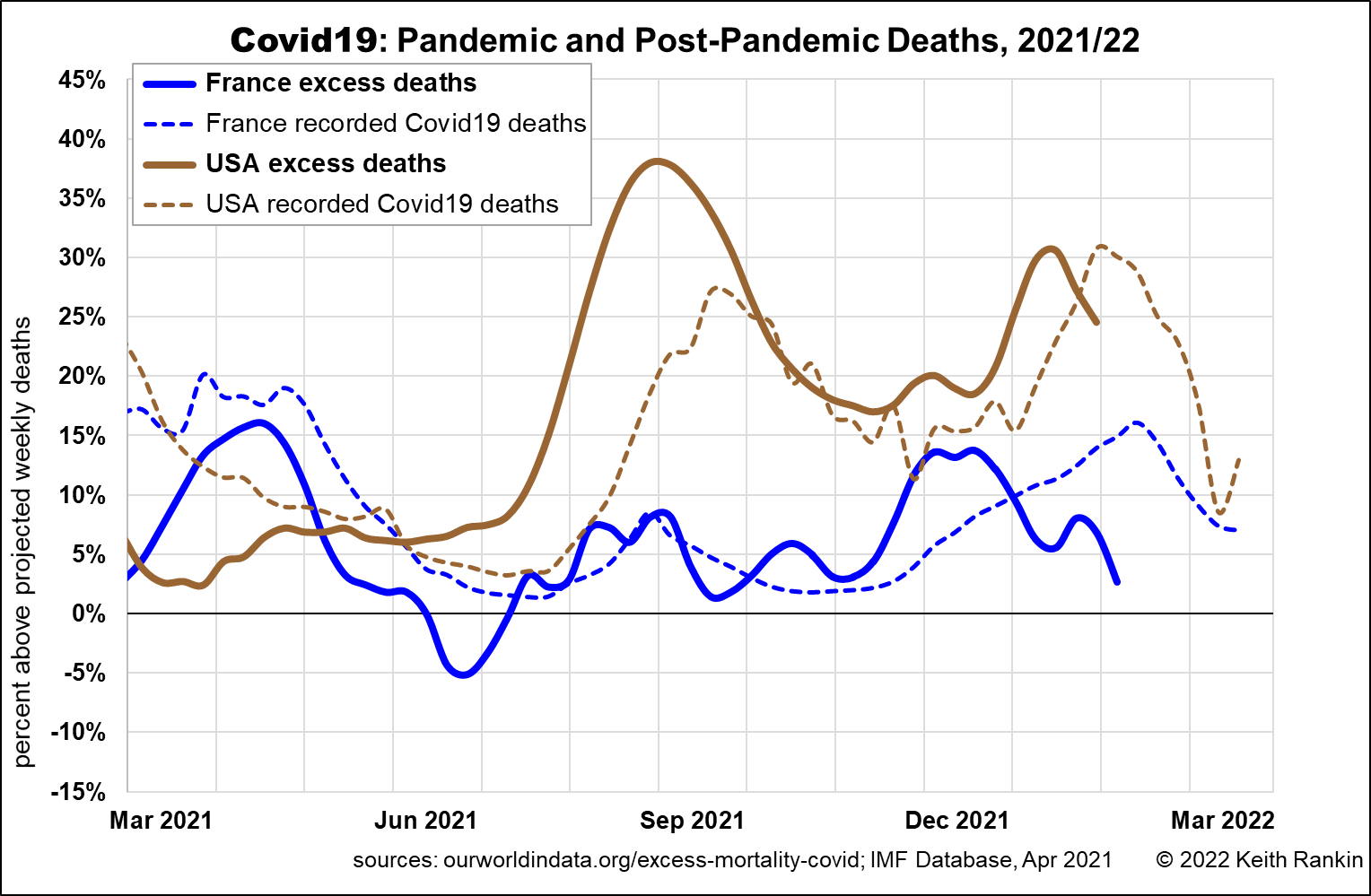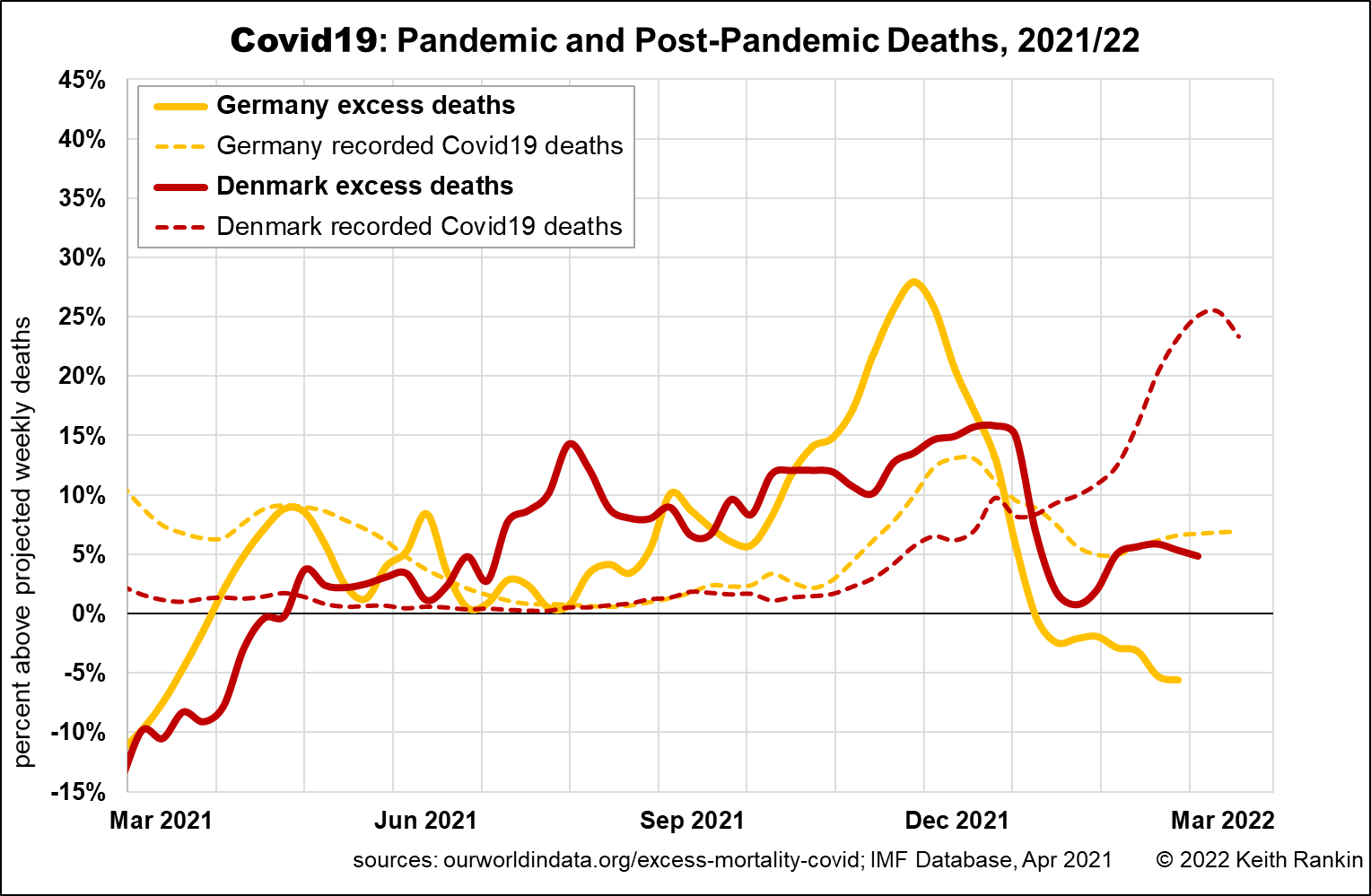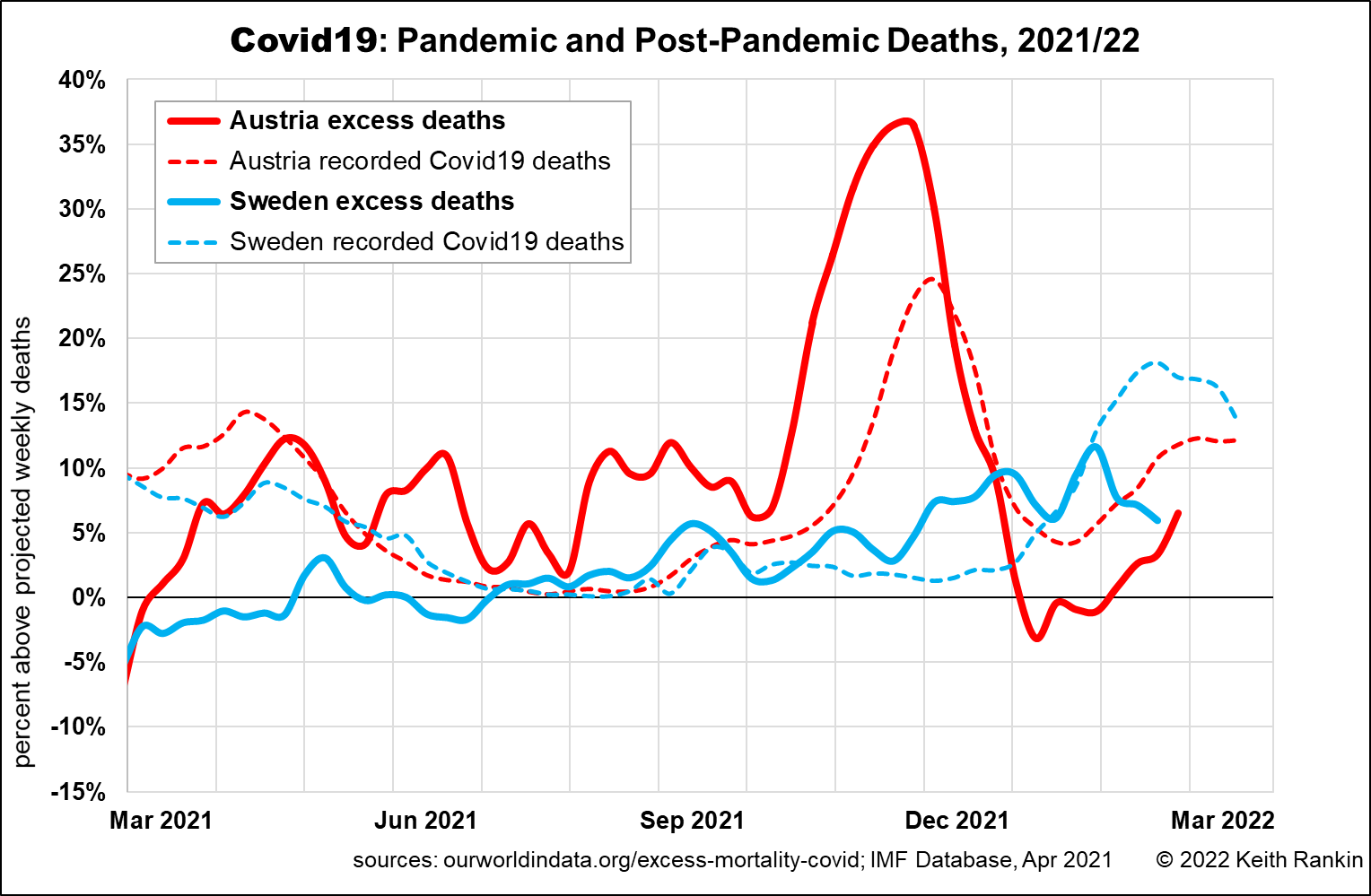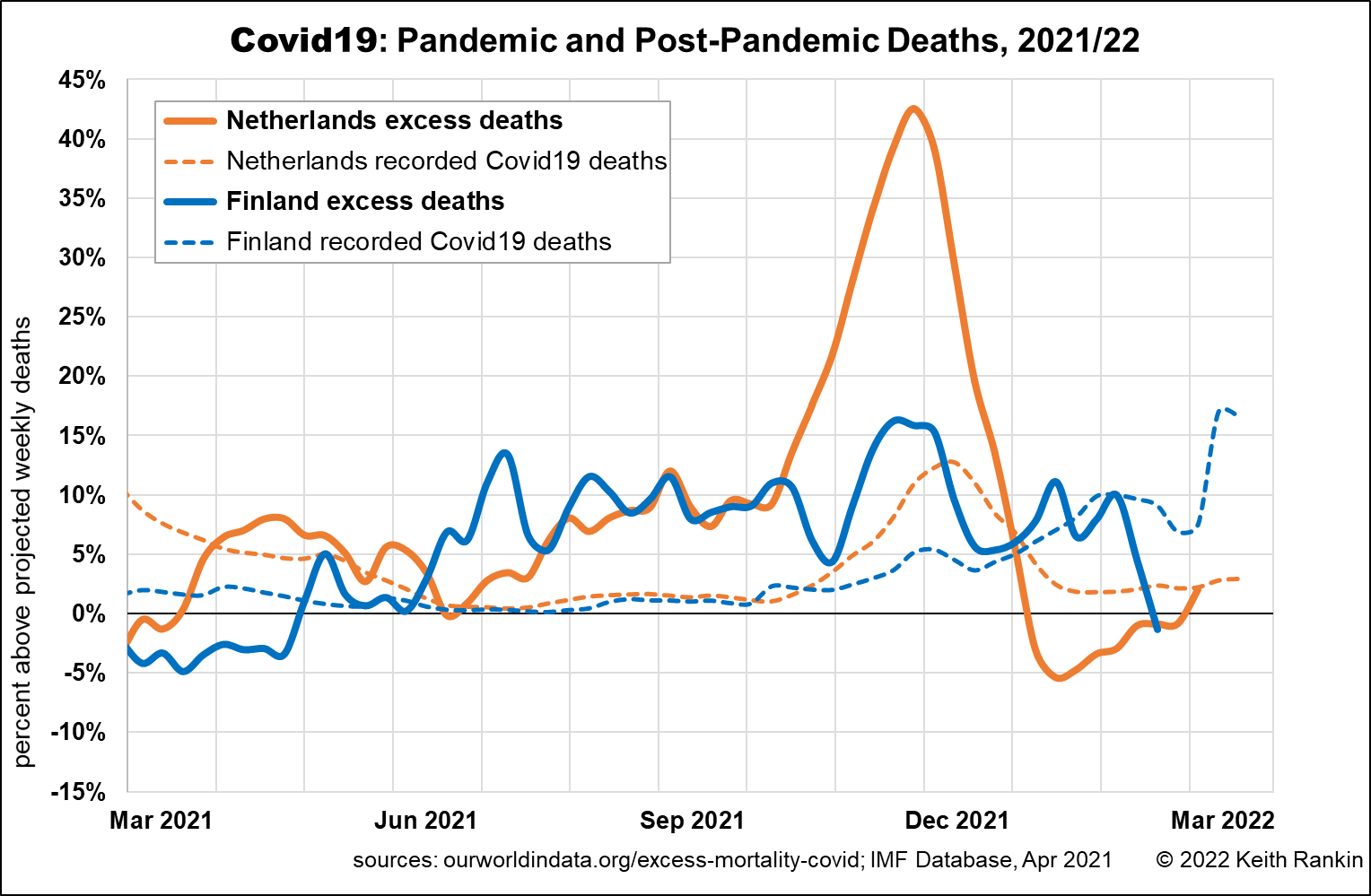Analysis by Keith Rankin.
These charts each compare, for the second year of the covid pandemic, a country with comparatively low mortality with another country with higher pandemic-related mortality. Each chart is to the same scale. And for each country, I will note its mask-mandate levels through the pandemic.
USA and France

France has performed surprisingly well, with delta-covid affecting deaths in August and December 2021; compared to higher delta-related deaths in USA around August and January.
France has a close relationship between excess deaths and covid-recorded deaths. The USA on the other hand shows that two significant covid-related death waves began before the recorded death waves. For both countries it is still too soon to evaluate the omicron-covid wave, although USA shows signs of a mortality upturn this month.
Ourworldindata publishes face covering policies. (The country with the least mandated use of facemasks is in fact Japan – not shown in today’s charts – which also is among the very best performers on Covid19 mortality.) These mask-stringency numbers are like the former Aotearoa lockdown-levels, with scores from 0 (no policy) to 4 (masks required in all public spaces). Level 1 means facemasks are “recommended”, but not mandatory even on public transport.
For the USA, the average ‘mask-mandate-scores’ were: 2.68 for the first six months of the pandemic (from March 2020), 3.95 for the next six months, then 3.41, and 2.89. The current score is 3.
For France, the scores were: 2.11, 4.00, 3.41, and 2.43. The current level is 2. So, while both countries have been mask-stringent, France has been less so. All strains of Covid19 spread widely through both countries, despite their mask policies. We know that French people were highly-infected, because they took covid with them, tragically, to all their holiday colonies; including New Caledonia and French Polynesia. So the reason for France’s relatively low mortality is its high mix of natural and vaccination immunity.
Germany and Denmark

In both countries, in the second half of 2021, actual pandemic mortality was substantially higher than recorded covid deaths. It is most likely that these extra deaths are mostly due to covid, during the delta wave. The omicron-covid wave shows up here, in 2022, with significant recorded deaths, and much lower excess deaths. Germany’s current lower level of excess deaths will be due to higher current anti-covid restrictions; thus Germany is likely to have postponed deaths in the coming summer months.
Re mask levels, Germany’s scores are: 1.71, 2.00, 2.00, 2.00. The current level is 2. Denmark’s scores are: 0.42, 2.00, 2.21, 1.70. The current level is 0.
Overall, in 2021/22, both countries’ mortality ‘performances’ are comparable. We may note that Denmark did better than Germany in 2020. Denmark has been more flexible than Germany in its masking policies. Its excess deaths are no longer being cushioned by policy restrictions.
Austria and Sweden

Sweden has clearly performed much better than Austria in 2021/22. Sweden has performed better than Denmark during this period; and better than France, too. While both countries show evidence of undiagnosed Covid19, for Sweden this was only for a short period around December. For Austria, underdiagnosis has been more pervasive. And Austria’s low excess deaths in January 2022 are almost certainly due to its much stricter rules than Sweden’s.
Re mask levels, Austria’s scores are: 1.71, 2.96, 2.51, 2.00. The current level is 2. Sweden’s scores are: 0.00, 0.44, 1.15, 0.21. The current level is 0. Further, if comparing Sweden with Japan, Swedes were less likely to be wearing masks than Japanese, during their ‘recommend only’ mask levels.
Sweden, with its non-authoritarian style of social neoliberalism, became well known as the country most reliant on individual responsibility vis-à-vis government compulsion. Its performance in 2021/22 bears out the success of its approach; although early mistakes meant that, in 2020, too many older people died with Covid19.
Netherlands and Finland

Both of these countries had substantial numbers of unrecorded covid-related mortality. This was true in 2020 as well, though with Netherlands having significantly more deaths from Covid19 than Finland. While Finland is showing more evidence than Netherlands of the omicron-covid wave in its recorded data, its most recent excess death data is looking as good as Netherlands, despite fewer restriction in January.
Re mask levels, Netherland’s scores are: 1.07, 2.00, 2.00, 2.53. The current level is 2. Finland’s scores are: 0.14, 1.00, 1.77, 1.00. Finland has resorted much less to facemasks than has Netherlands. Of the countries shown here, the only one which performed better in the 2021/22 mortality stakes was Sweden. And Sweden is the only one of these countries with lower facemasking requirements.
The country with the most severe facemasking requirement has been United States. And it’s the worst performed.
Conclusion
Wearing facemasks has not saved lives. Rather, most likely facemasks have contributed to a severely compromised level of personal immunity to a range of potentially fatal conditions. While, Aotearoa New Zealand seems to have bucked the trend so far, my best guess is that AoNZ will have higher excess death levels in 2022 than any of these charted countries. Not all of these deaths will be clinically due to Covid19; many will be due to compromised general levels of immunity. Wearing facemasks may have contributed to loss of life in Europe and elsewhere.
One radio item worth listening to is: Concerns about other winter viruses post lockdown era, RNZ, 24 March 2022.
*******
Keith Rankin (keith at rankin dot nz), trained as an economic historian, is a retired lecturer in Economics and Statistics. He lives in Auckland, New Zealand.








